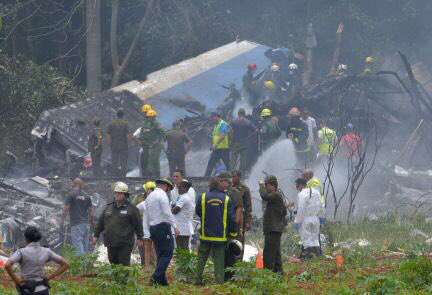A passenger plane with 104 people on board has crashed shortly after take off from Havana’s main airport.
State media reported that there were three survivors in a critical condition after the Boeing 737 jet, which was en route from Jose Marti International Airport to the eastern Cuban city of Holguin, came down.
Flight CU972 was scheduled to depart at 11am local time (4pm BST) and land an hour and 20 minutes later.
The jet came down close to the airport with photos shared on social media showing a large plume of thick, black smoke rising from near the terminal buildings.
Havana’s air hub is a short way southwest of the Cuban capital, and has pockets of population nearby as well as a major highway near one end of the runway.
There is concern that people on the ground may be among the casualties.
Residents of the rural area said they had seen some survivors being taken away in ambulances.
A military officer who declined to provide his name to reporters said that there appeared to have been only three survivors in critical condition, but other officials declined to confirm that figure.
Cuba’s president, Miguel Díaz-Canel, said he feared that there would be many fatalities.
Crash investigators are at the scene alongside police and firefighters.
What appears to be a charred wing and other parts from the plane were scattered on the ground.
A post on Cubana’s website urged families of the passengers to contact the airline using two telephone numbers.
Plane tracking app FlightRadar24 showed an American Airlines jet having departed from the airport shortly after the crash, suggesting the runway remained open, however it was closed a short time later.
Cuban state media originally reported that the aircraft had been chartered from an Italian carrier, Blue Panorama. That airline is operating flights for Cubana, but the aircraft involved in the accident appears to have belonged to a Mexican carrier, Global Air.
The 420-mile flight to Holguin was scheduled to take just over an hour. Given the destination – a large city in the east of the island – it is likely to have had a mix of families, tourists, business travellers and government officials on board.
While Cuba has had an accident-free run of nearly 18 years, in the last three years of the 20th century it suffered four fatal accidents.
Cubana de Aviación, the national airline, has had a troubled history. As a result of the US economic embargo, it has been largely reliant on Russian and European aircraft. Maintenance of its relatively elderly fleet has been a constant challenge.
The practice of chartering in aircraft and crew, known as “wet leasing”, is widely used around the world.
In 1999, a DC-10 jet belonging to the French airline, AOM, suffered a fatal accident while flying for Cubana. After a flight from Havana it overshot the runway at Guatemala City.







































